MARIANI’S
Virtual
Gourmet
August 16
, 2020
NEWSLETTER
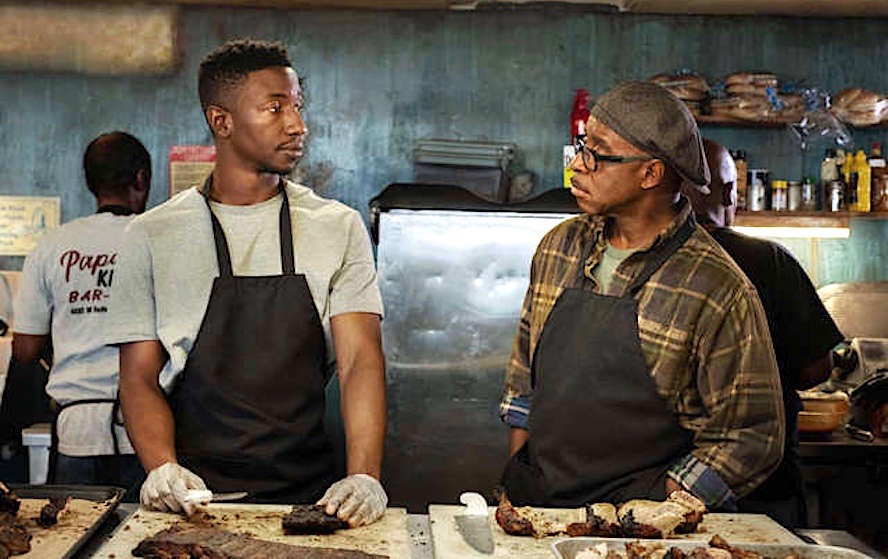
❖❖❖
IN THIS ISSUE
DINING AROUND LAKE COMO
By John Mariani
LOVE AND PIZZA
CHAPTER TWENTY-ONE
By John Mariani
NOTES FROM THE WINE CELLAR
WINES FOR LATE AUGUST
By John Mariani
❖❖❖
DINING AROUND LAKE COMO
By John Mariani
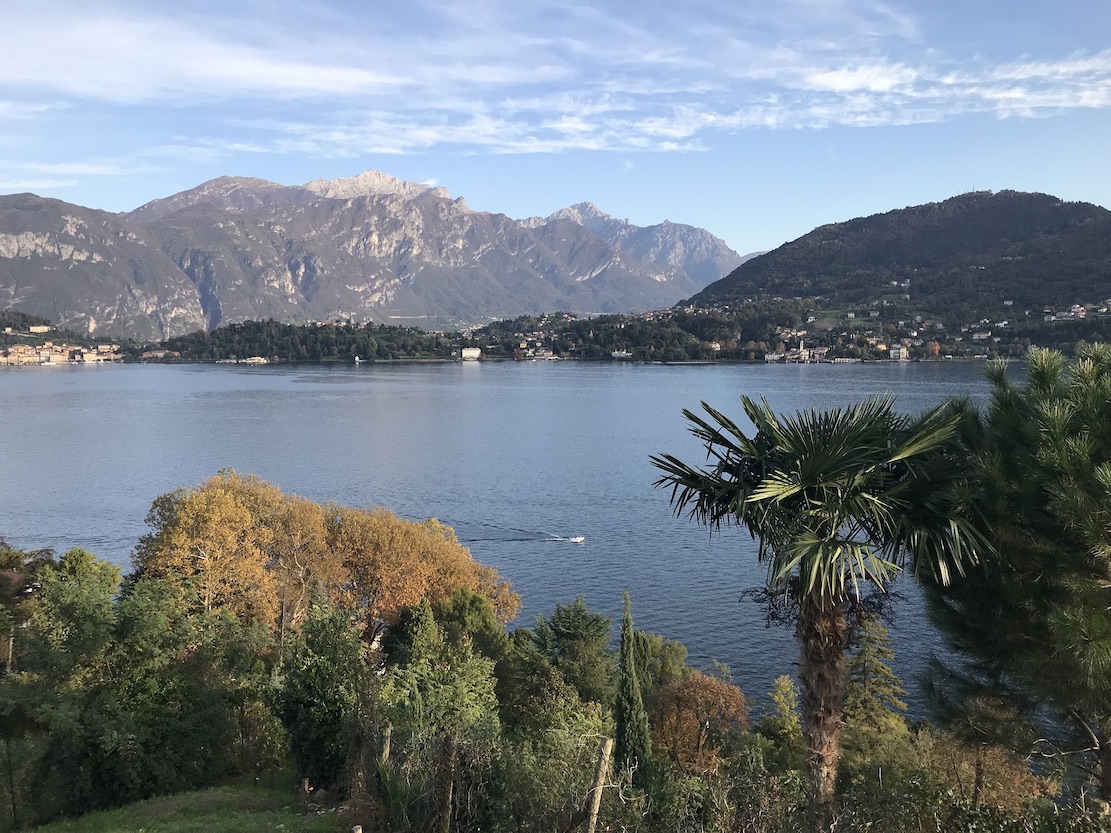
It’s possible that everything
sounds better in Italian—even “lawnmower,” which
is falciatrice
da prato—and
there are few words that sound as beautiful as
the place they describe: Lago di Como has the
same lilt to it that the lake’s choppy waters
do, made blue by the sky’s reflection and
caressed by gently sloped mountains with the
names Grgina, Resegone and Legnone on either
side.
As a resort area Lake Como is best known for
stately hotels like the Grand Tremezzo, Belvedere,
Villa Serbelloni and others, and at its southern end
is the enchanting small city of Como (which I’ll be
writing about next week). Two of the prettiest towns
on the lake are Tremezzo and Bellagio, just across
from each other and reachable by frequent ferries.
Tremezzo, since 1947, is a commune of three
towns—Tremezzo, Lenno and Mezzegra—whose most
beautiful sight is the Villa Carlotta, built in the 18th
century, and now open to the public, including its
extraordinary garden that winds up the hillside in a
seeming natural landscape, albeit one very well
manicured.
The Villa was given to Princess Charlotte of
Prussia as a wedding present when she married George
II, Grand Duke of Sachsen-Meiningen, in 1850, and
now inside it is an impeccably restored museum, with
its rooms brightly lighted by sun pouring through it
huge windows. The rooms have private apartment
period furniture, painted arched ceilings, musical
instruments for concerts given there, and, at the
moment, an exhibition of textile history that
includes models of looms created by Leonardo da
Vinci. Among many fine statues, there is an
exquisite original cast by Canova of the Muse
Terpsichore (1808) showing the marker nails used to
pinpoint reference points for the marble statue to
come.
I wrote
a few weeks back about the Grand Tremezzo, where I
stayed and dined so elegantly, but there are a slew
of little trattorias lining the shore road of
Tremezzo. Up a winding road from the lake is one of
my favorite trattorias in northern Italy, as quaint
and rustic as might be imagined in this magical
little town: La
Fagurida (Via Rogaro 17;
344-40-676), opened in
1974. 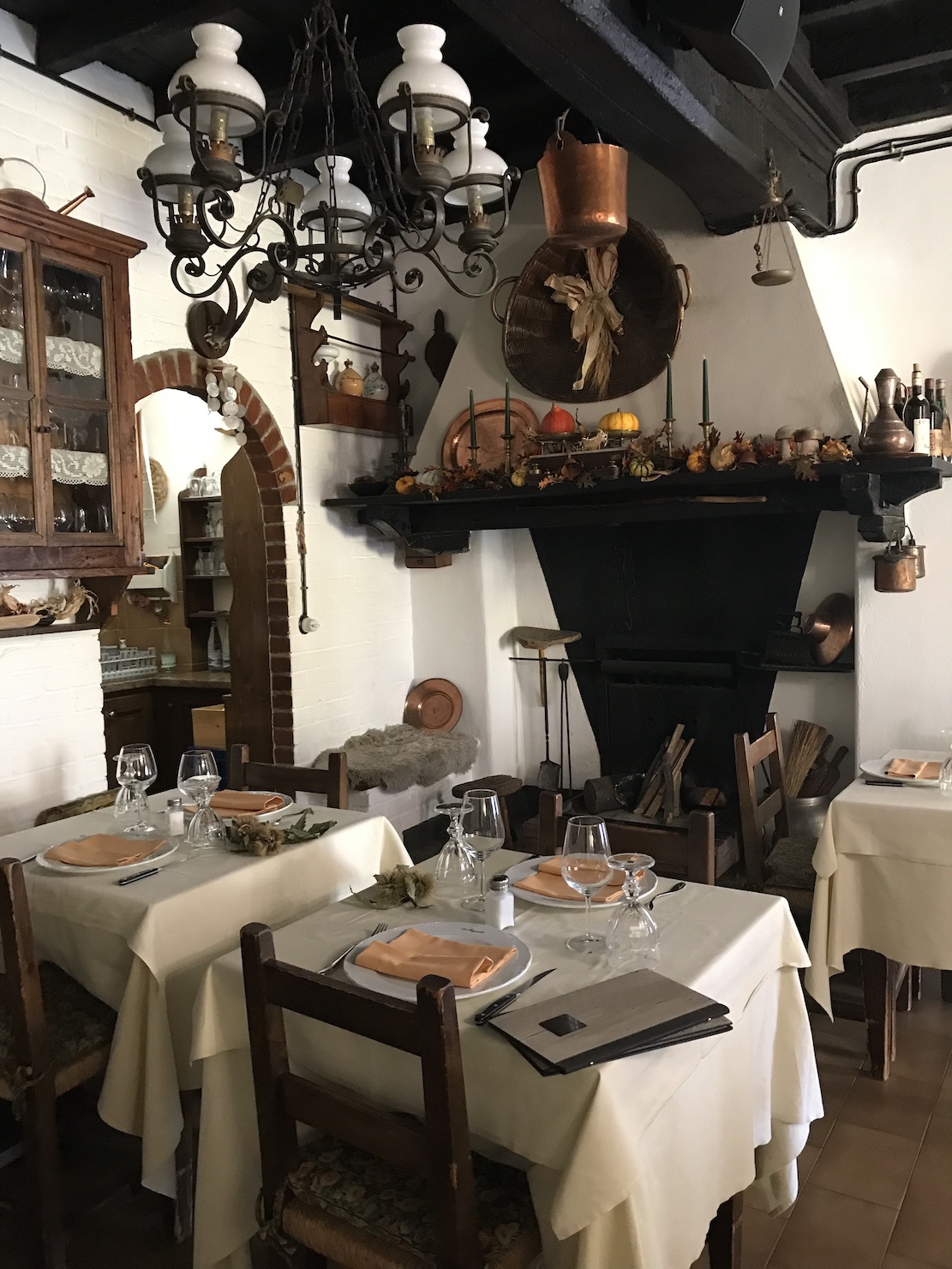
Every inch of the compact place, with two
dining rooms (right)
and a stone terrace, indicates it is family run,
from the small kitchen to the nicely set old wooden
tables. It was a quiet afternoon when my wife and I
arrived, serenaded by the breezes in the pines and
the far-off horn of the ferry boat on the lake.
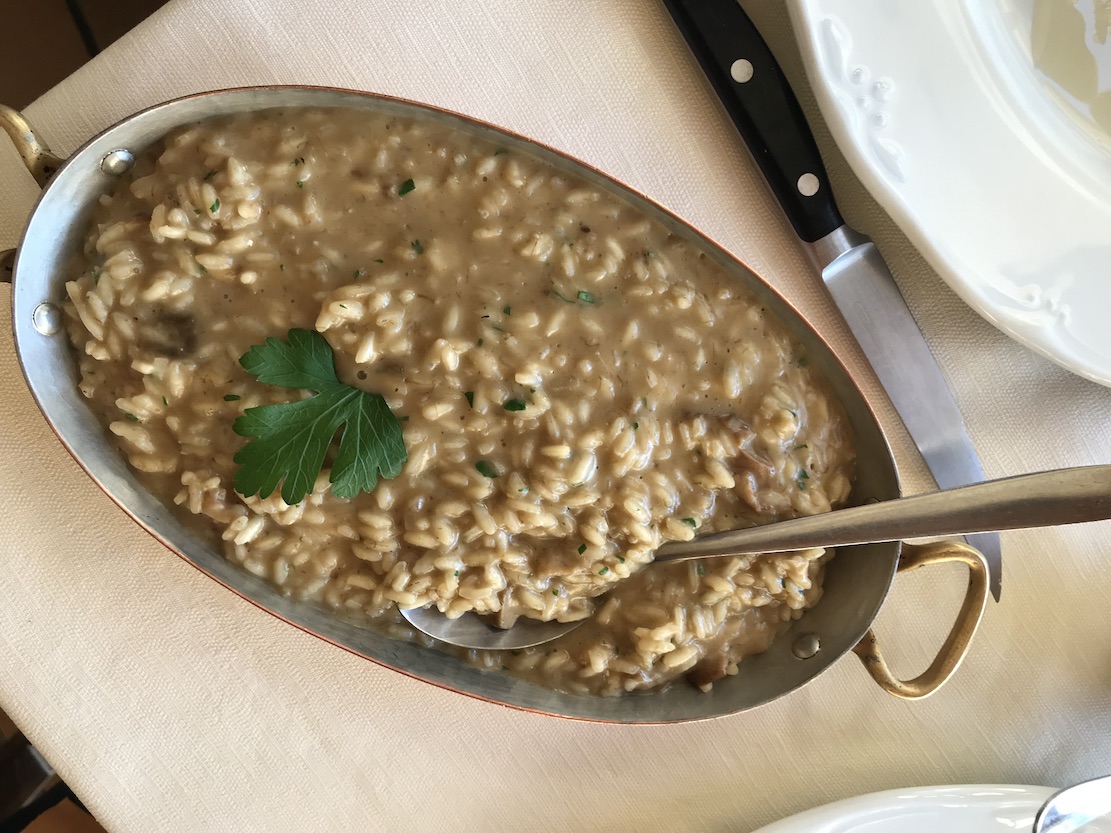 The menu is a single page,
and one notices there is no pasta on it. What there
is, however, is a sumptuous polenta laced with a
great amount of Lombardian bitto cheese
made from both cow’s and goat’s milk, and garlic.
Risotto with funghi
porcini (left)
was creamy and the perfect texture, the freshness of
the mushrooms intense. There was a very juicy
braised rabbit, and a simply cooked lorello
lake fish grilled with lemon and sage.
The menu is a single page,
and one notices there is no pasta on it. What there
is, however, is a sumptuous polenta laced with a
great amount of Lombardian bitto cheese
made from both cow’s and goat’s milk, and garlic.
Risotto with funghi
porcini (left)
was creamy and the perfect texture, the freshness of
the mushrooms intense. There was a very juicy
braised rabbit, and a simply cooked lorello
lake fish grilled with lemon and sage.
After dining at La Fagurida, I cannot imagine
ever being in the Lake Como area without driving to
this wonderful trattoria of familial authenticity
and honest cooking. A three-course meal will cost
less than 50 euros, including tax and service, per
person. 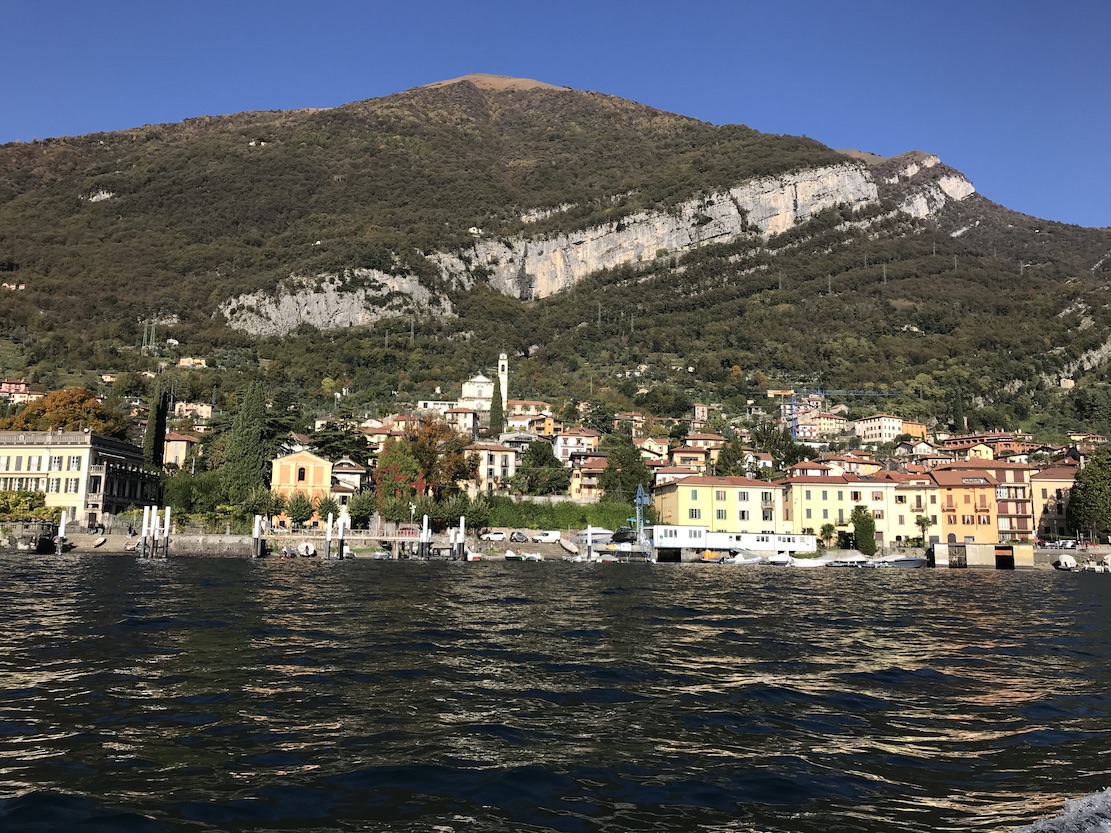
La Darsena (Via Regina, 3;
344 43.166) is a
small hotel and ristorante
with a large dining room and glass walls
overlooking the lake. Chef Marcello serves
rigorously Lombardian cuisine along with an
excellent wine list. My wife and I found the food
good if not exceptional. We enjoyed a large
raviolo with funghi
porcini, braised pork ribs, and a nicely
grilled branzino
with a light mayonnaise-based sauce. The dessert
selection was quite good, too. A three-course meal
will run about 50 euros, with tax and service.
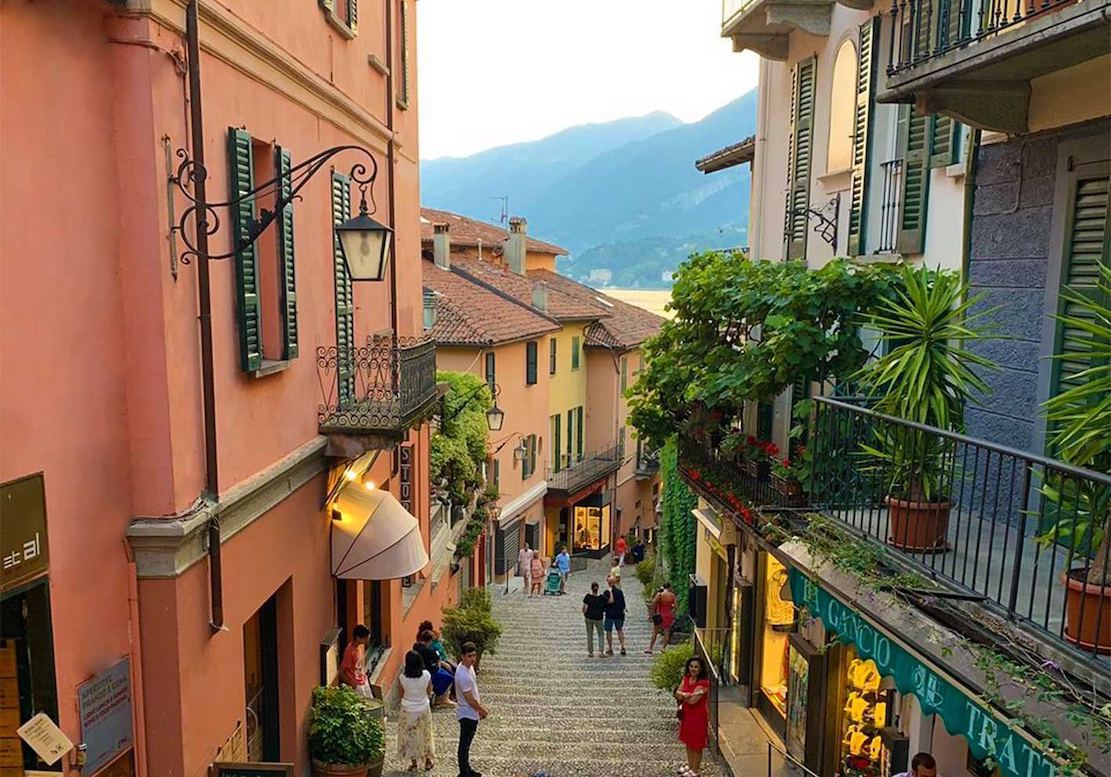 On
the eastern shore, across from Tremezzo, is Bellagio
(above),
strikingly built up over centuries on the
hillside, with steep stone walkways at the
top of which, on Via Garibaldi, is a gorgeous park
and a street lined with boutiques of very fine
quality, including three owned by the same family,
Saraceno, each carrying different merchandise, from
hand-picked fashions to bracelets
On
the eastern shore, across from Tremezzo, is Bellagio
(above),
strikingly built up over centuries on the
hillside, with steep stone walkways at the
top of which, on Via Garibaldi, is a gorgeous park
and a street lined with boutiques of very fine
quality, including three owned by the same family,
Saraceno, each carrying different merchandise, from
hand-picked fashions to bracelets 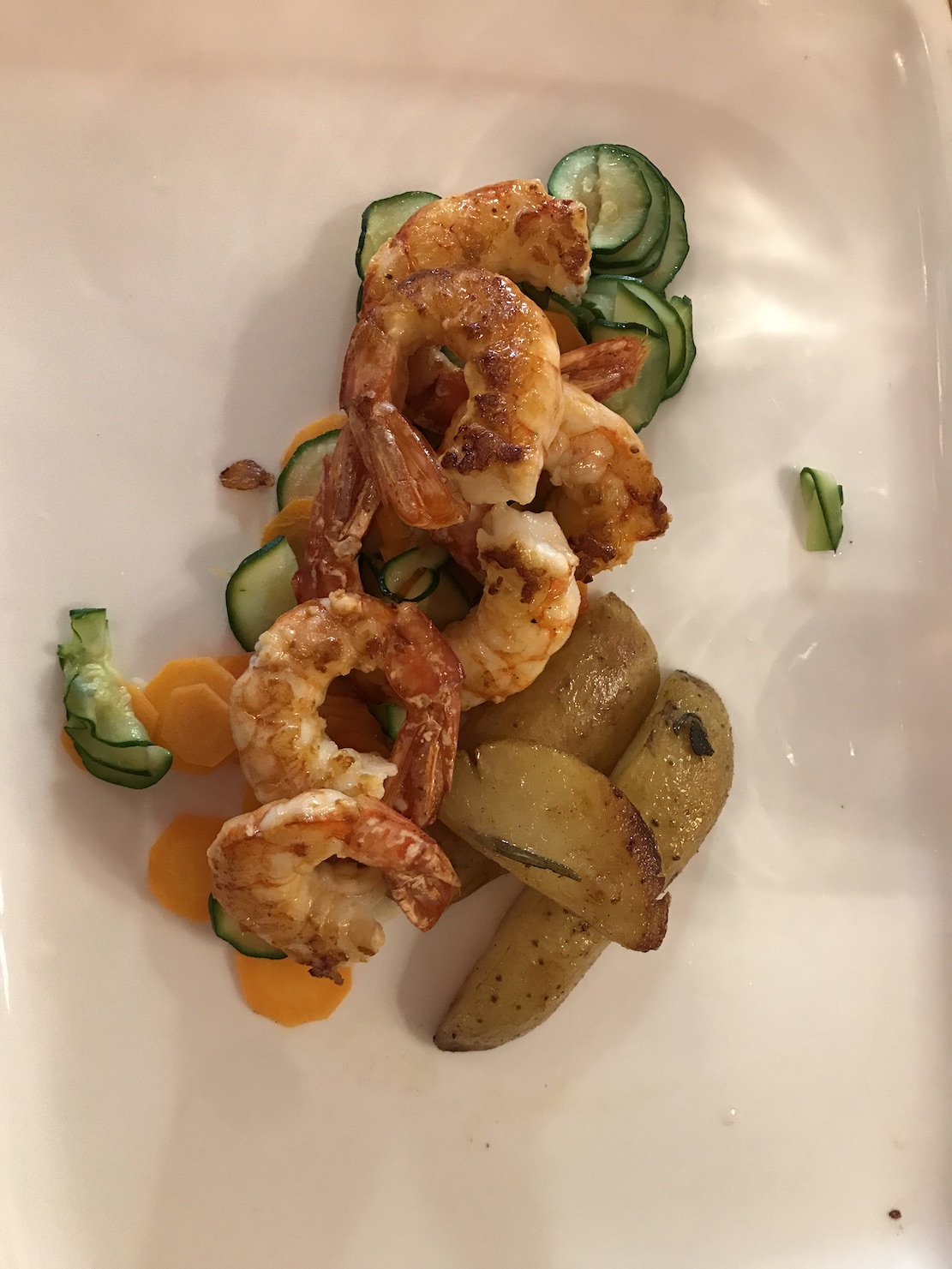 and men’s clothes.
and men’s clothes.
Bellagio’s waterfront is thronged with
tourists well into autumn, and most come on the
ferry, have a pizza, then leave, so the mornings and
late afternoons are ideal for wandering the quiet
streets. There you’ll find the gated Villa
Serbelloni hotel, with its long hallways,
high-ceiling rooms with grand views and an oddly
innovative dining room best appreciated at dinner.
My
wife and I had received many good reports on Bilacus (Salita
Serbelloni 32; 31 950-480), for the last six
years run by Aurelio Gandola and his family, at the
top of those steep steps, so it was a pleasure to
drop onto a chair in the sunny trattoria to be
coddled by its amiable staff. The place gets an
international tourist crowd, so the menu is printed
in several languages. We enjoyed cheese ravioli with
more funghi
porcini, then in season, along with five fat gamberone
with carrots and zucchini (right), all of it cooked at the
ideal temperatures.
There is also an impressive enoteca on
the premises that offers one of the region’s best
wine lists, especially for Lombardian bottlings.
Antipasti cost about 14 euros, Pastas run 15 and
main course average 15-19 euros.
❖❖❖
By John Mariani
LOVE AND PIZZA
Since, for the time being, I am unable to write about or review New York City restaurants, I have decided instead to print a serialized version of my (unpublished) novel Love and Pizza, which takes place in New York and Italy and involves a young, beautiful Bronx woman named Nicola Santini from an Italian family impassioned about food. As the story goes on, Nicola, who is a student at Columbia University, struggles to maintain her roots while seeing a future that could lead her far from them—a future that involves a career and a love affair that would change her life forever. So, while New York’s restaurants remain closed, I will run a chapter of the Love and Pizza each week until the crisis is over. Afterwards I shall be offering the entire book digitally. I hope you like the idea and even more that you will love Nicola, her family and her friends. I’d love to know what you think. Contact me at loveandpizza123@gmail.com
—John Mariani
To read previous chapters go to archive (beginning with March 29, 2020, issue.
LOVE AND PIZZA
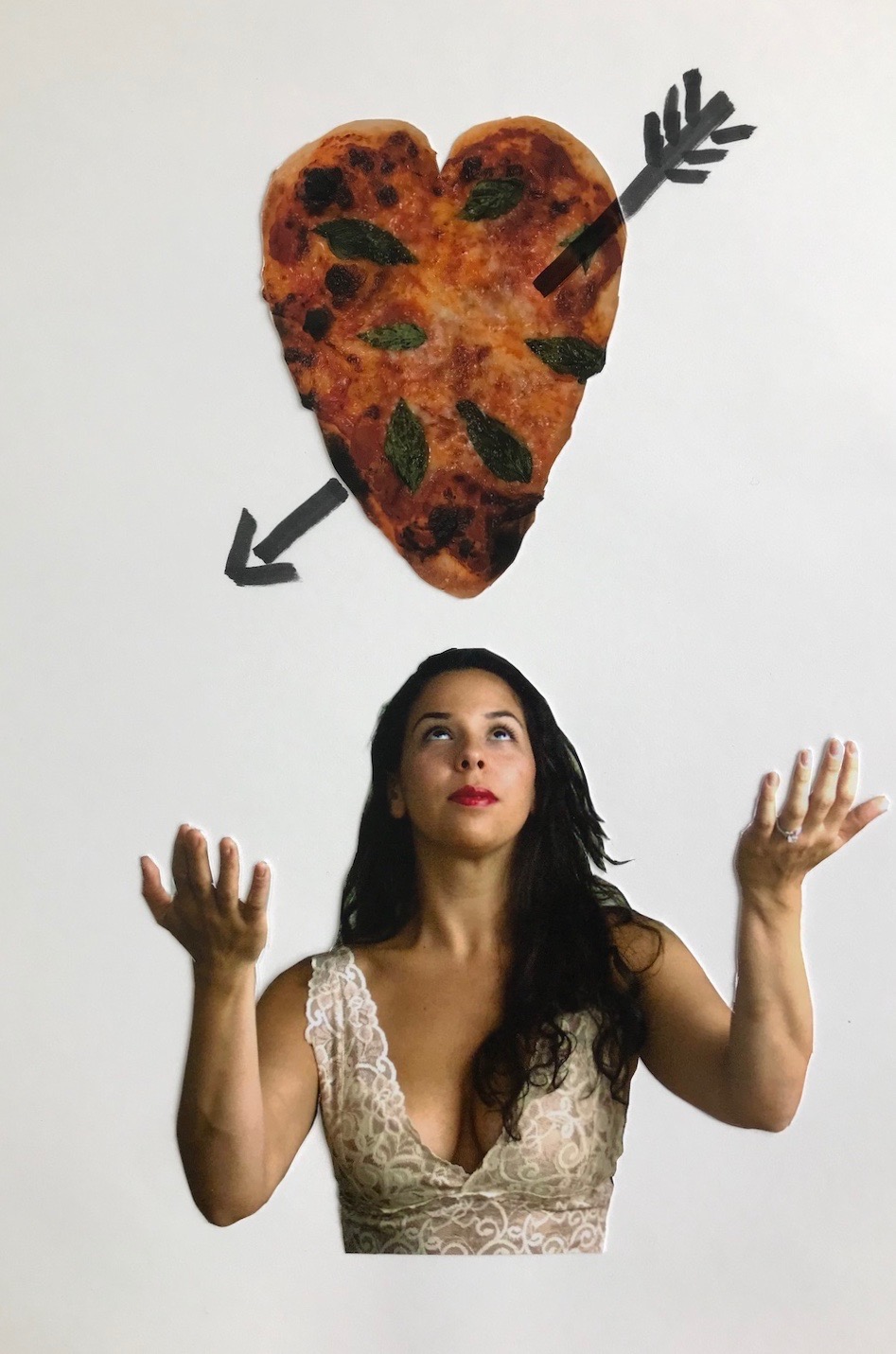
Cover Art By Galina Dargery
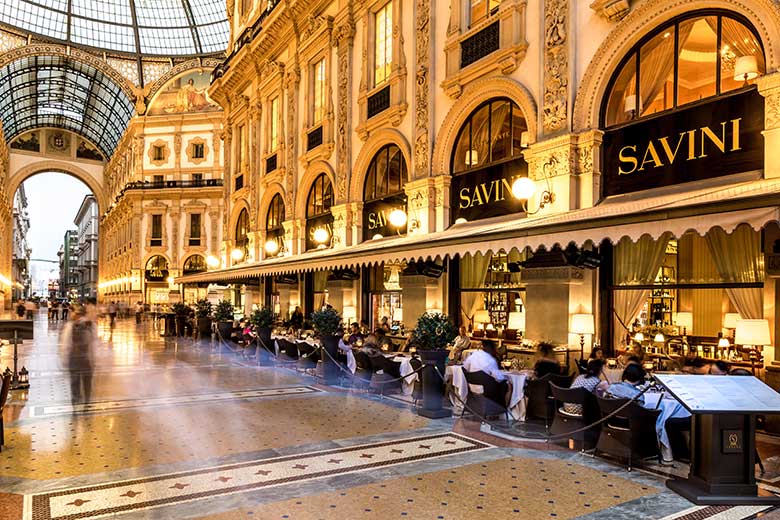
Giancarlo
had decided to be right on time, well, closer
to 8:30, and Nicola decided to be fashionably
late, too.
As a matter of fact, she’d arrived
earlier but held back, hiding behind one of
the massive archways of the Galleria until she
saw Giancarlo arrive. Since
the night was warm enough to dine al fresco,
he asked for a table outside, under a white
canopy. The
cameriere,
who was very familiar with Il Marchese
Cavallacci, unfolded his guest’s napkin and
asked if he’d like to see the wine list while
waiting.
For a few moments Nicola just stood and
looked at Giancarlo, impeccably dressed in a
double-breasted gray flannel suit with a white
button-down shirt and a thick silk tie
deliberately set just a half inch askew against
his collar.
Seeing that it was twenty minutes after
eight, she circled back past the archway so that
it seemed she was coming straight from the
piazza in front of the Duomo, as the yellow moon
moved out from beyond a cloud.
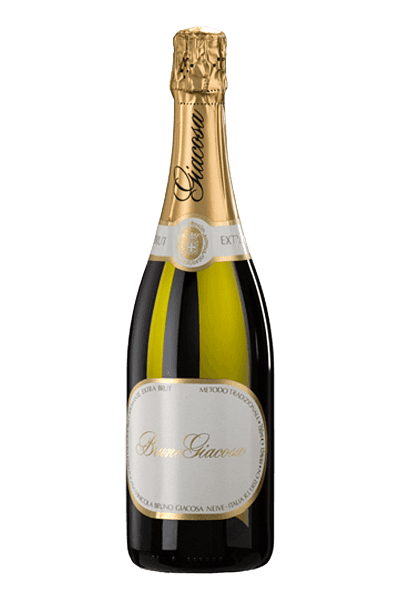 He
saw her coming toward him—Nicola using the
nonchalant walk she had displayed on the runway,
her hips slightly swaying with each step, not
shifting up and down on her legs like pistons,
as the other models did. As he
rose from the table, Nicola sprang her smile on
him and Giancarlo feigned—or so it seemed—a
small swoon.
He
saw her coming toward him—Nicola using the
nonchalant walk she had displayed on the runway,
her hips slightly swaying with each step, not
shifting up and down on her legs like pistons,
as the other models did. As he
rose from the table, Nicola sprang her smile on
him and Giancarlo feigned—or so it seemed—a
small swoon.
“Ciao,
Nicola,” he said, “You look so beautiful!”
“Grazie,
Marchese,” she replied, fully knowing
Giancarlo did not expect her to use the
aristocratic title. “What
a gorgeous night!”
“It cost me a great deal of money,” he
joked, immediately cursing himself for saying
something so stupid.
The cameriere
hurried over to seat Nicola but, seeing
Giancarlo was already behind her, stayed back
for a moment then greeted the new arrival,
calling her “Signorina Santini,” as he’d been
informed by Giancarlo. He
then turned and brought a bottle of spumante—not
the sweet Asti Spumante made from moscato grapes
but a dry version made from pinot nero grapes.
“I
hope you like this wine,” Giancarlo said as the
cameriere
popped the bottle’s cork and poured the
fragrant, frizzante
wine into their glasses. “It is
made by the Giacosa winery for my family using
the French méthode champenoise, so it’s more
like Champagne. Salute!”
Nicola sniffed the wine then tasted it,
bringing out her broad grin. “Oh, Giancarlo,
this is so
delicious. It is a lot like
Champagne”—remembering when her father had
served the French bubbly upon the news that
she’d be going to study in Italy and when Signora Palma
had ordered it at Bagutta.
“The Italians have made magnificent
progress in producing excellent wines,” said
Giancarlo, “and I’m proud to say many of the
best are from Piemonte, where I’m from. So
tonight, we drink only Piemontese wines, okay? The
wine cellar here carries all the best
names—Giacosa, Gaja, Pio Cesare, Prunotto, all
the best.”
Sensing he might have too easily gone
into a reverie on Italian viticulture that might
bore Nicola, he said, “But, Nicola, tell me how
you are feeling this week.”
Nicola, too, feared boring her host with
a dolorous description of her family’s sorrow,
so she simply said, “It was difficult for a few
days, but my grandmother told my family she
didn’t want me to fly back to New York to watch
her fade away and that it was her dream for me
to be here in Italy, so ...”—she lifted her
glass, “Let’s drink to mia nonna
tonight! I’m sure she is looking down on us
right now.”
They
clinked glasses again and both felt assured that
the night would now be all theirs to enjoy and
to get to know each other without the intrusion
of other people.
“So, what did you do this week,
Giancarlo?” asked Nicola.
“Nothing worth talking about. Work, work,
work. Contracts. Things I needed to get away
from. The
family business is strong, but my father, he is
not so well and he is worried that I, as his
male heir, will not want to take on all the
responsibility of both the investment company
and the marble company. Or
maybe he thinks I am not actually capable of
doing it.”
“Are you?”
“I think so. I don’t know. I went
to school to learn the investment part, but I
think I have more of a head and heart for the
rest of the company. But that’s not the part
that makes much money. What I
do know is that I am not made for the board
room, which my father adores because he comes
from a long line of men who love nothing more
than to make a strong deal that always turns out
much better for him than for his competitors. He
feels he truly needs
to win. I’m not quite that, well, determined, I
suppose.”
“What about your sisters?” asked Nicola.
“Well, one is a doctor, the other is
studying to be a lawyer. I think they feel
relieved that they won’t be expected to hold the
company together when my father dies.”
“And your mother?”
Giancarlo smiled. “My mother is a
fascinating woman, and she is totally devoted to
my father.
So,” he said, moving his hands as  if he
were scooping the air, “We have a lot of, shall
I say, interesting discussions, and I have to
fight back a little. But,
forgive me, I don’t want to speak about all
that. I
want to eat and to look at you all night,
Nicola. By
the way, may I ask where you got that beautiful
dress?”
if he
were scooping the air, “We have a lot of, shall
I say, interesting discussions, and I have to
fight back a little. But,
forgive me, I don’t want to speak about all
that. I
want to eat and to look at you all night,
Nicola. By
the way, may I ask where you got that beautiful
dress?”
“Will it come as a surprise if I tell you
that I got it from Signora
Palma?”
“Ah, Signora Palma!
She is an extraordinary woman, a true diva. Neapolitan,
you know. Very dramatic!”
“I have noticed that about her.”
“And she is an old family friend. Her
clothes are a little too stylish for my mother
to wear but my sisters do.”
Nicola ran her finger around the base of
the wine glass. “Do you mind if I ask you if Signora
Palma was ever married?”
Giancarlo smiled slightly and nodded,
“Yes, she was married for a long time to a very
nice, very smart man who handled all the
company’s finances for years. But to
make a long story short, it turned out that he
led another life, as a gay man.”
“You’re kidding!”
“No, I’m not. But
the sad thing was that Signora
Palma, who in her business had been around gay
men her whole professional life, wasn’t bothered
so much by his being gay. She
thought they could live civilized, separate
lives within the same walls, and they did for a
while.”
“So what happened?”
“Ah, eventually he told her he had fallen
in love with a younger man and that he was
moving out of her life entirely. Which he did. I
don’t think they’ve seen each other in five
years.”
“That is so sad,” said Nicola.
“Si,
but, as you can see, La Signora
is very tough, very resilient, very ...
Neapolitan!
And she worked harder and got better at
the business side of running the company, and
she’s done very well. Now
she’s ready to conquer the world.” Then,
leaning in towards Nicola, he said, “And she’s
got a new boyfriend.”
Nicola was so happy to hear the news she
asked, “Was he at the party the other night?”
“Oh, yes,” said Giancarlo. “He was the
tall Italian gentleman.”
“Lucio? Her investor?”
“Ah, you met him then.”
“Wow, that’s terrific. I’m so
happy for her.”
“Well, let’s order dinner. I’m very
hungry. Are you?”
“Starving.”
 “Do you
mind if I order for the two of us? I’ve learned
over the years what they do best at Savini.”
“Do you
mind if I order for the two of us? I’ve learned
over the years what they do best at Savini.”
Nicola shrugged in agreement and
Giancarlo called over the cameriere
and asked to see the menu. “Do
you want to look at the menu, Nicola?”
“Sure,” opening the overlarge folio with
pages of items, all without prices.
“You like risotto
alla milanese? They do it very well here.
Then, if you like pigeon, they cook it
perfectly, not too rare. Then
we see about dessert.” Giancarlo
brought back the waiter with a wave of his hand
and ordered for the two of them, adding that
he’d like a bottle of Angelo Gaja Barbaresco,
saying to Nicola, “Have you had Gaja’s wines?”
She shook her head, having little
experience with Italian wines outside of the
carafes she and her friends usually ordered.
“I think you will love it. Gaja
is a magnificent revolutionary! He really
challenged all his colleagues to make better
wines by making different wines,
and
in the bargain breaking many worn-out
traditions.
Now his Barbaresco is considered one of
the world’s great red wines, like a Bordeaux or
Burgundy cru. But you tell me what you think
when we drink it.”
There
was still some spumante
left, and, while waiting for the first course,
they nibbled on grissini breadsticks,
very thinly sliced prosciutto and warm puffy focaccia
bread glossed with olive oil.
“Oh this is so delicious,”
said
Nicola.
“I’m a little surprised you eat bread.
I’ve never known any model
who eats bread, and most of them don't eat much
pasta.”
“Well, if I do any more modeling, I may
have to stop eating both. But I
will tell you one thing, Giancarlo.”
He looked comically intrigued, waiting
for what she’d say.
“Pizza,” she replied. “I
cannot imagine
a world without pizza.”
“Oh, I love
pizza!,” said Giancarlo. “And I love the New
York pizza—it’s thicker than they make it here,
but, of course, Milan is not a city for pizza. For
that you have to go to Napoli.”
“Or to a place called Bella Napoli on
Arthur Avenue in the Bronx. It’s probably the
best pizza in the entire city.”
“Now that sounds like it's worth a trip
to New York,” he laughed, then said, “By the
way, Nicola, when do you go back to New York?”
“Well, the plan was to finish the
semester and go back in May, but I got an offer
from a new American fashion magazine to do some
modeling, and they said they’d fly me back
during Easter week, when I’m off from school
anyway.”
“So you do want to model?”
Nicola took a deep breath. “I’m really
not sure, Giancarlo. The money is good, of
course, and it seems easy, so if I have the time
while I’m studying, maybe I might do something
now and then.
But from the little I’ve seen and all
I’ve read, it just isn’t the way I see my life
going. The business just seems to rip through
these girls, then discards them.”
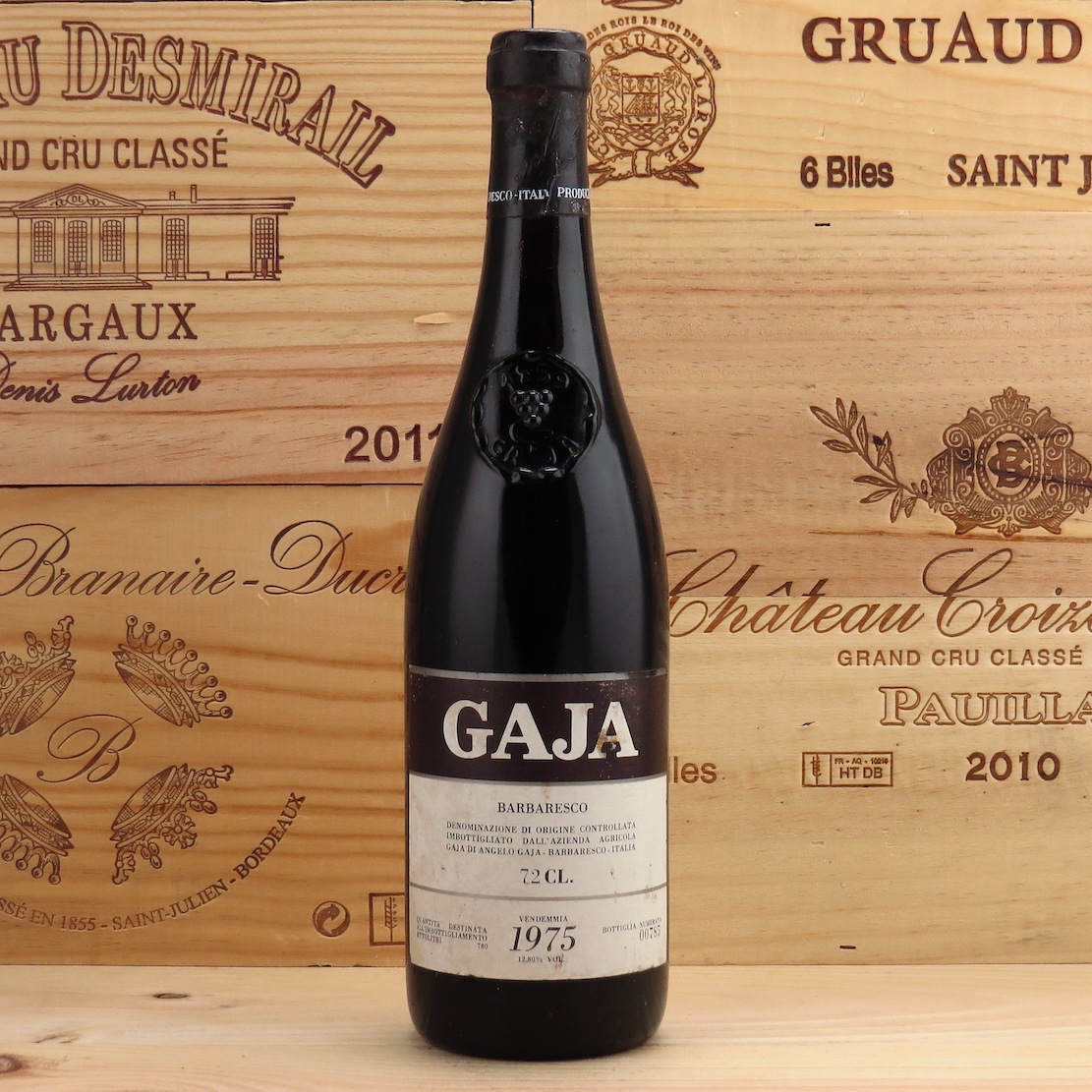 Nicola had
in fact been thinking a lot about a once famous,
dark-haired, dark-eyed Italian-American model
named Gia Carangi, the daughter of an Italian
restaurant owner in Philadelphia. Gia
had become a rebellious teenager, obsessed with
extreme fashion and open about her bisexuality.
In 1978, at the age of 17, she signed with
Wilhimina Models in New York and had a meteoric
rise to stardom, becoming an overnight favorite
of the era’s best photographers, who put her on
the cover of every important magazine within
months.
Nicola had
in fact been thinking a lot about a once famous,
dark-haired, dark-eyed Italian-American model
named Gia Carangi, the daughter of an Italian
restaurant owner in Philadelphia. Gia
had become a rebellious teenager, obsessed with
extreme fashion and open about her bisexuality.
In 1978, at the age of 17, she signed with
Wilhimina Models in New York and had a meteoric
rise to stardom, becoming an overnight favorite
of the era’s best photographers, who put her on
the cover of every important magazine within
months.
And then, at a time when fashion and the
club scene conspired to kill off their young,
Gia was lured into heroin addiction. Before long
her needle marks needed to be airbrushed from
photos. Her
beautiful face became drawn and sallow. Losing
contracts and bouncing from one agency to
another, she fell in and out of drug use, so
that by the end of 1982 only catalog work was
available to her; on her last job Gia was
dismissed by a German mail-order clothing
company for being stoned during the shoot.
And so, of no further use to the
industry, Gia Carangi was forgotten, and it was
said that by 1985, in and out of treatment,
she’d been working as a checkout clerk, then
in the cafeteria of a nursing home.
Nicola merely mentioned Gia Carangi’s
name to Giancarlo and said she had no intention
of ending up like her. Giancarlo
said he remembered the name vaguely as one of
the top models a few years back.
“Anyway,” said Nicola, “I haven’t the
time for the foreseeable future to do even much
part-time modeling much less as a full-time
career.”
“Well,” said Giancarlo, touching her
hand, “I for one think you are unusually
beautiful among the girls on the magazines right
now.”
At that moment, the risotto arrived and
the cameriere
opened the bottle of Gaja Barbaresco. “Buon
appetito,” he said after allowing
Giancarlo to approve the wine.
Scented and colored by saffron, the
risotto was a rich golden yellow color, its
fragrance rising in the air. The
rice was creamy—what Italian cooks call “all’onda,”
wave-like,
and its texture was tender, almost chewy,
suffused with rich chicken broth, butter, white
wine 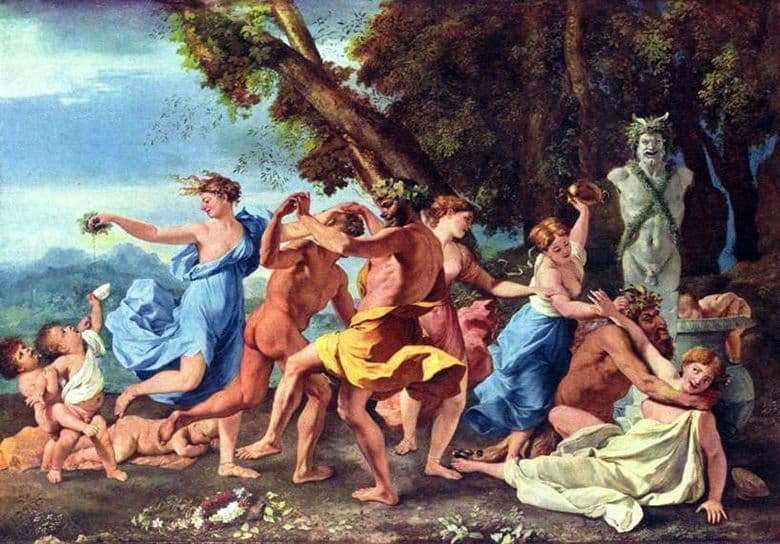 and Parmigiano cheese.
and Parmigiano cheese.
Nicola
sipped the wine and nearly gasped. “Oh my
God, Giancarlo, this really is the
best wine I’ve ever tasted,” she said, trying
not to betray her ignorance of wines of this
quality and price.
“It tastes like ... it tastes like what
they must drink in paradise.”
“Or at least on Mount Olympus, perhaps.”
“Yes. You see so many paintings of the
Greek bacchanalia. Poussin did several."
“Si,
and Tintoretto, no?”
“Oh, yes, he’s one of my favorite
painters.”
“Well, then you must go to Venice. That’s
where all the best Tintorettos are.”
“I’d hoped to get there this semester,
but time is running out.”
“Well,
maybe we could go together some time before the
semester ends,” said Giancarlo, trying to make
it seem like an innocent day trip. “It’s only
about three hours’ drive or by train.”
“I think I’d like that,” replied Nicola,
well aware that the suggestion was not quite so
innocent.
© John Mariani, 2020
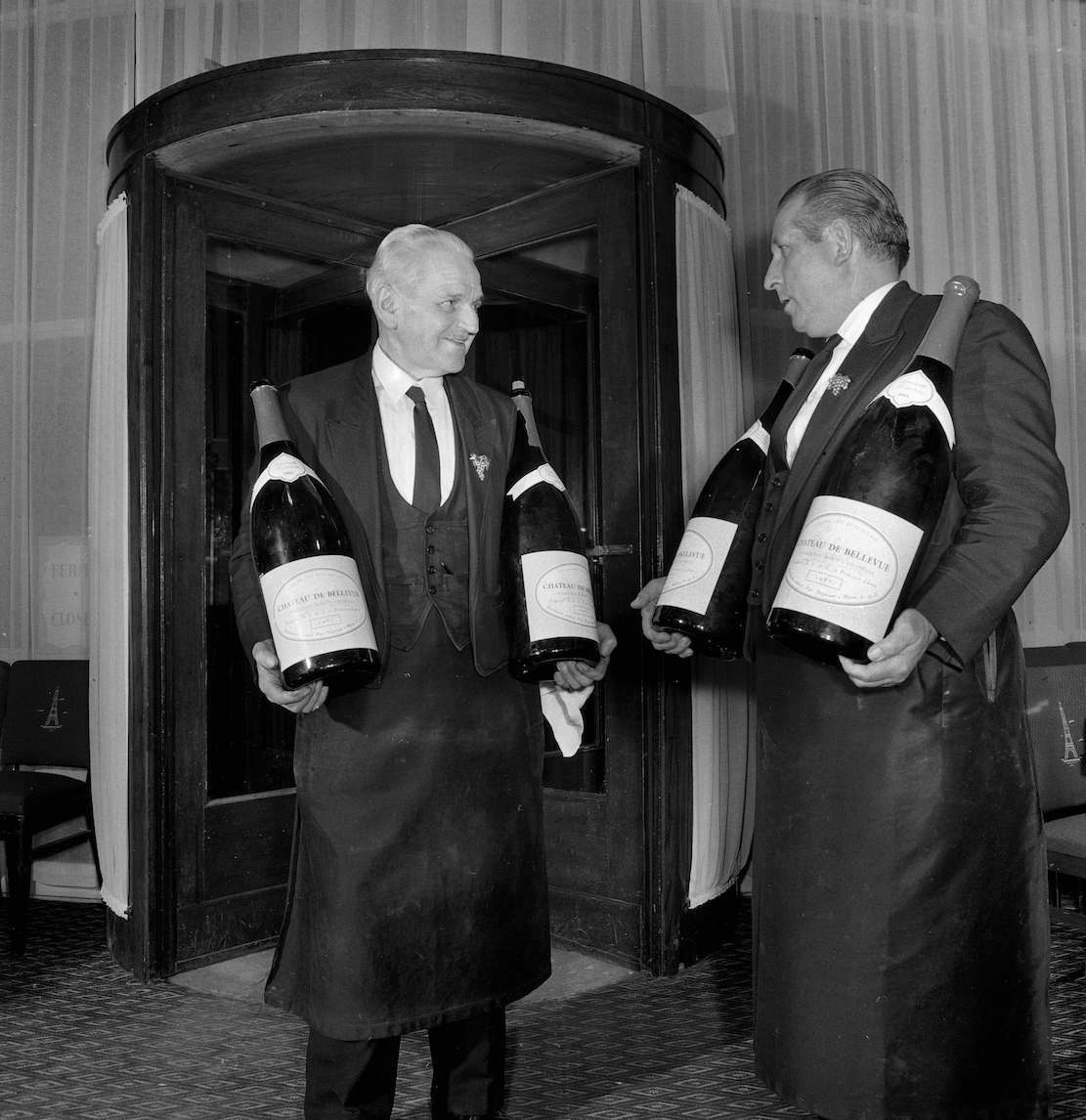 WINES
OF THE WEEK
WINES
OF THE WEEK
By
John Mariani
Sylvia Plath
called August “the odd, uneven time,” and there
is certainly a hope that the worst heat of
summer will be gone and the air will smell of
early autumn by month’s end. For me it’s a time
to rustle about the wine cellar to try bottlings
I’d lost track of and so seem good options for
the late days of summer. 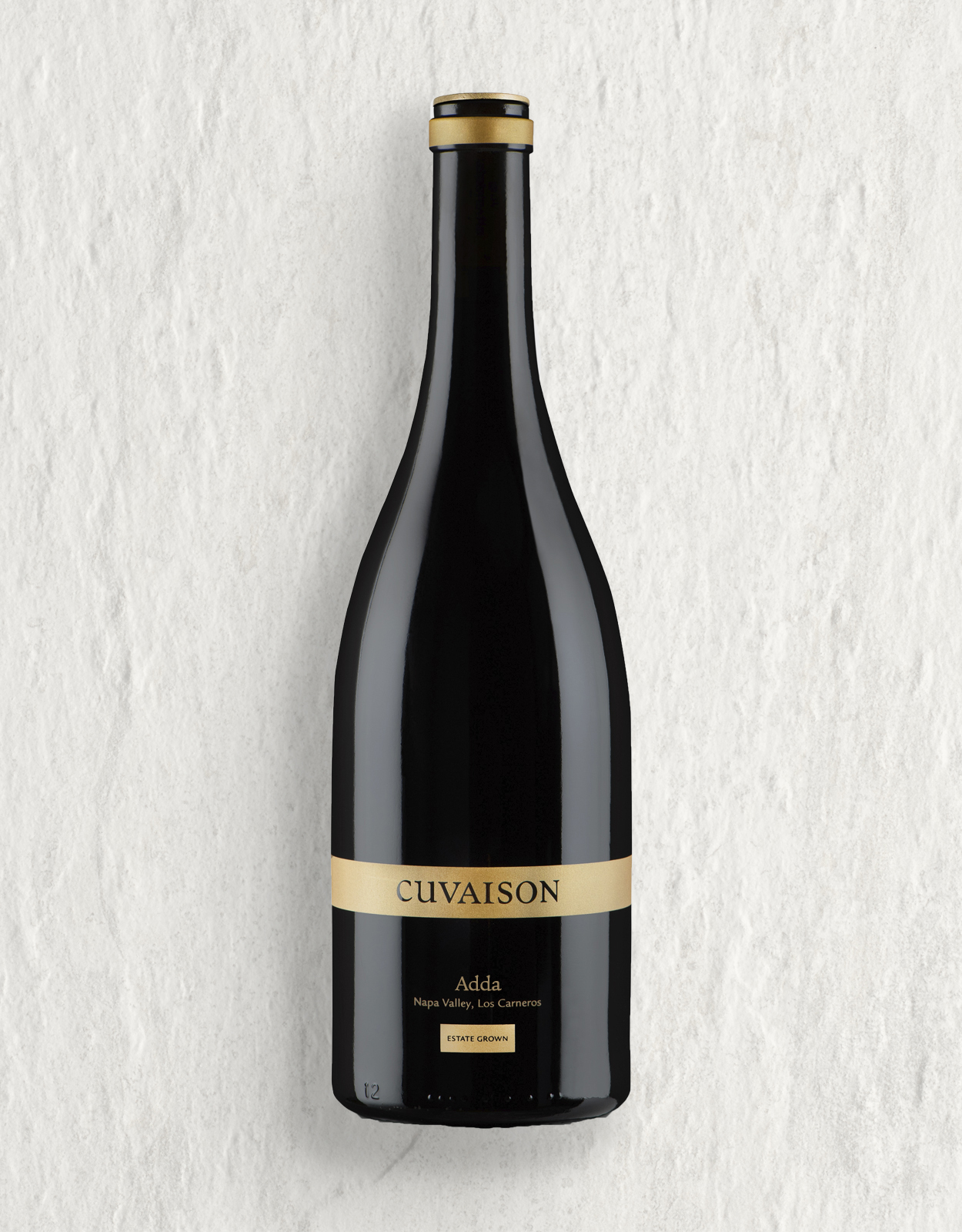
CUVAISON
ADDA PINOT NOIR 2018
($80)— Not cheap, but this is the venerable
Cuvaison’s top-of-the-line Pinot Noir in its
Legacy Tier from its Los Carneros estate, and
shows the experience of this winery, which was
begun by fourth-generation winemakers of the
Schmidheiny family, who purchased their vineyard
land in 1979 and acquired 400 acres of the best
terroir in Napa Valley in 1991. Since 2002,
winemaker Steve Rogstad has aimed for elegance and
that’s what you get in this bottle, which, while
Californian in style, can compete with many fine
Burgundies for finesse.
LE
VOLTE DELL’ORNELLAIA 2018
($35)—This is the second label of the illustrious
Ornellaia estate in Tuscany, but for a lot less
money you get a very applaudable approximation of
its top-of-the-line wine. Estate Director Axel
Heinz has always aimed for complexity in his
wines, stressing a balance of fruit, spice and
acid, and you’ll know on the first sip this is
very much an Italian wine of good breeding. With
game birds, there is none better.
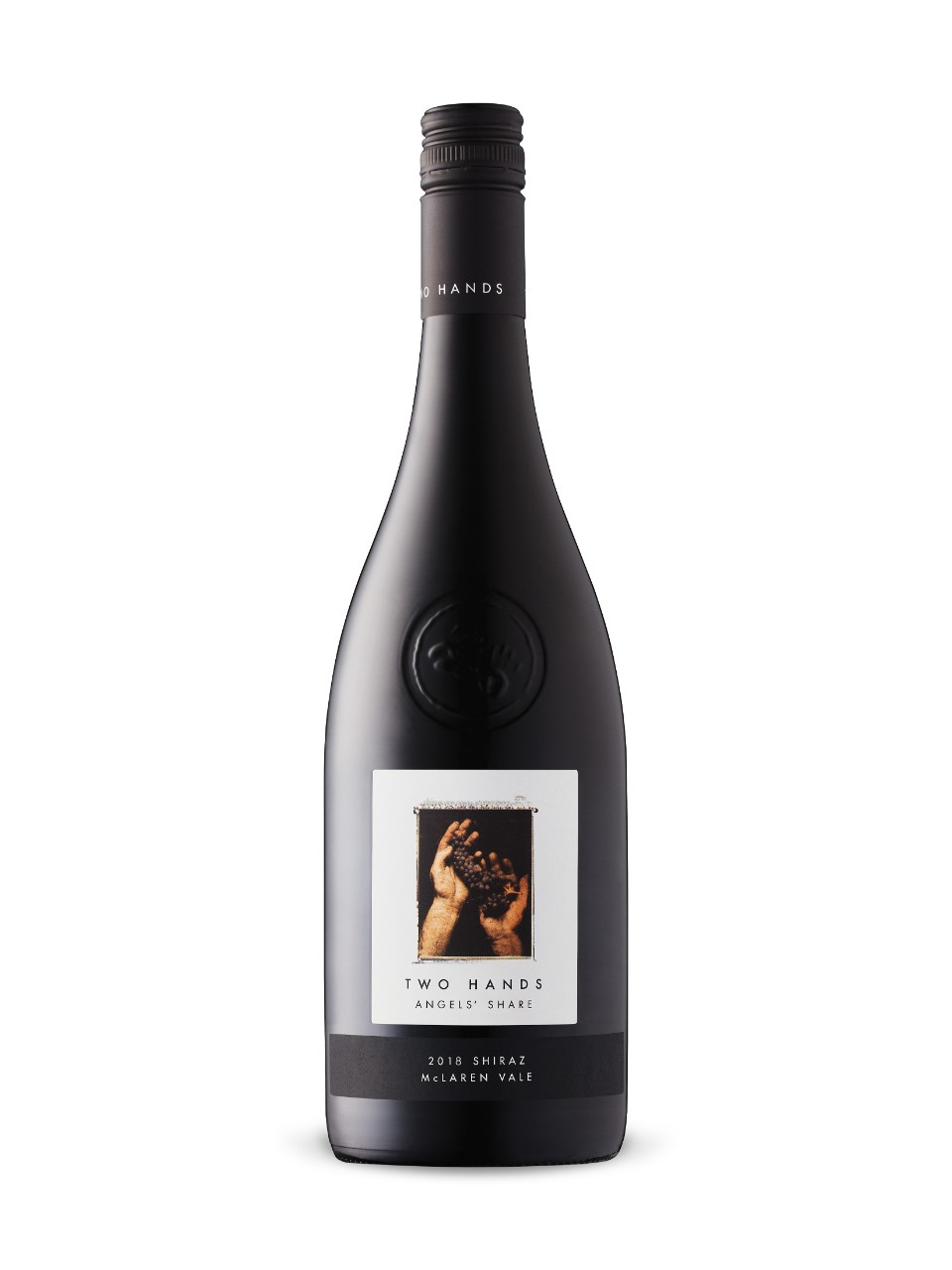 TWO HANDS ANGEL’S SHARE SHIRAZ
2018
($30)—Shiraz (elsewhere called Syrah) is not an
easy grape to work with, or perhaps too easy if
you’re just aiming for a fruit bomb with big
tannins. Two Hands Angel’s Share (the name refers
to the amount of wine that evaporates through the
barrel into the air, and thereby is enjoyed by
angels) manifests the generosity of Australian
winemaking in the richness of its mid-palate
flavors along with pleasing spiciness and velvety
texture. The wine could certainly match with
barbecued pork, but it would be heavenly with this
autumn’s game like venison, quail or, if you can
find it, grouse.
TWO HANDS ANGEL’S SHARE SHIRAZ
2018
($30)—Shiraz (elsewhere called Syrah) is not an
easy grape to work with, or perhaps too easy if
you’re just aiming for a fruit bomb with big
tannins. Two Hands Angel’s Share (the name refers
to the amount of wine that evaporates through the
barrel into the air, and thereby is enjoyed by
angels) manifests the generosity of Australian
winemaking in the richness of its mid-palate
flavors along with pleasing spiciness and velvety
texture. The wine could certainly match with
barbecued pork, but it would be heavenly with this
autumn’s game like venison, quail or, if you can
find it, grouse.
DOMAINE ROY & FILS YAMHILL-CARLTON ROSÉ OF
PINOT NOIR 2019 ($39)—My
favorite roses are made from either Provençal
Grenache or Oregon Pinot Noir. The 2019 vintage in
Oregon’s Yamhill region was a cool one, so the
aromatics were rich but refined in this fine
example. Owing to the Pinot Noir it’s a deep rose
color, with 13.5% alcohol, which is a little
higher than most roses but it therefore has the
body to go well beyond the aperitif stage and
marry well with pork or chicken this summer.
FLORAL
DE MELGAÇO ALVARINHO OLD VINES VINHO VERDE 2019 ($17)—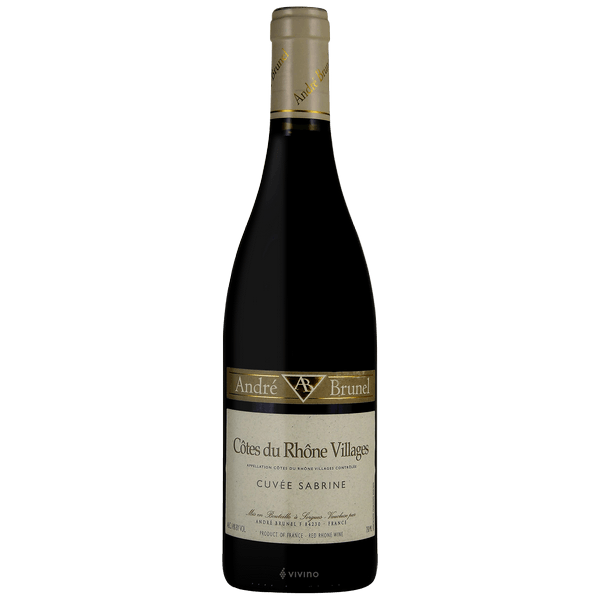 Portugal’s Vinho Verdes used to be
cheap, slightly fizzy, green wines that never
reached above the level of warm weather
drinkability. This one, however, with 13% alcohol,
has a lot more complexity going for it, due to the
use of old vines that have character, fresh fruit
and a bracing acidity, making the wine a delicious
seafood match, especially white fish like cod or
halibut.
Portugal’s Vinho Verdes used to be
cheap, slightly fizzy, green wines that never
reached above the level of warm weather
drinkability. This one, however, with 13% alcohol,
has a lot more complexity going for it, due to the
use of old vines that have character, fresh fruit
and a bracing acidity, making the wine a delicious
seafood match, especially white fish like cod or
halibut.
ANDRÉ
BRUNEL CÔTES DU RHÔNE VILLAGES CUVÉE SABRINE
2016
($20)—With a blend of 80% Grenache and 20% Syrah,
this village appellation wine has a lot of dark
fruit and good body that is just right for
drinking at this stage in its development. The
concentrated flavors and soft tannins show off the
blend of these two Rhône varietals at a high
degree of expertise.
Sponsored by

Any of John Mariani's books below may be ordered from amazon.com.
 The Hound in Heaven
(21st Century Lion Books) is a novella, and
for anyone who loves dogs, Christmas, romance,
inspiration, even the supernatural, I hope you'll find
this to be a treasured favorite. The story
concerns how, after a New England teacher, his wife and
their two daughters adopt a stray puppy found in their
barn in northern Maine, their lives seem full of promise.
But when tragedy strikes, their wonderful dog Lazarus and
the spirit of Christmas are the only things that may bring
his master back from the edge of despair.
The Hound in Heaven
(21st Century Lion Books) is a novella, and
for anyone who loves dogs, Christmas, romance,
inspiration, even the supernatural, I hope you'll find
this to be a treasured favorite. The story
concerns how, after a New England teacher, his wife and
their two daughters adopt a stray puppy found in their
barn in northern Maine, their lives seem full of promise.
But when tragedy strikes, their wonderful dog Lazarus and
the spirit of Christmas are the only things that may bring
his master back from the edge of despair. WATCH THE VIDEO!
“What a huge surprise turn this story took! I was completely stunned! I truly enjoyed this book and its message.” – Actress Ali MacGraw
“He had me at Page One. The amount of heart, human insight, soul searching, and deft literary strength that John Mariani pours into this airtight novella is vertigo-inducing. Perhaps ‘wow’ would be the best comment.” – James Dalessandro, author of Bohemian Heart and 1906.
“John Mariani’s Hound in Heaven starts with a well-painted portrayal of an American family, along with the requisite dog. A surprise event flips the action of the novel and captures us for a voyage leading to a hopeful and heart-warming message. A page turning, one sitting read, it’s the perfect antidote for the winter and promotion of holiday celebration.” – Ann Pearlman, author of The Christmas Cookie Club and A Gift for my Sister.
“John Mariani’s concise, achingly beautiful novella pulls a literary rabbit out of a hat – a mash-up of the cosmic and the intimate, the tragic and the heart-warming – a Christmas tale for all ages, and all faiths. Read it to your children, read it to yourself… but read it. Early and often. Highly recommended.” – Jay Bonansinga, New York Times bestselling author of Pinkerton’s War, The Sinking of The Eastland, and The Walking Dead: The Road To Woodbury.
“Amazing things happen when you open your heart to an animal. The Hound in Heaven delivers a powerful story of healing that is forged in the spiritual relationship between a man and his best friend. The book brings a message of hope that can enrich our images of family, love, and loss.” – Dr. Barbara Royal, author of The Royal Treatment.
 |
The Encyclopedia of American Food and Drink by John F. Mariani (Bloomsbury USA, $35) Modesty forbids me to praise my own new book, but let me proudly say that it is an extensive revision of the 4th edition that appeared more than a decade ago, before locavores, molecular cuisine, modernist cuisine, the Food Network and so much more, now included. Word origins have been completely updated, as have per capita consumption and production stats. Most important, for the first time since publication in the 1980s, the book includes more than 100 biographies of Americans who have changed the way we cook, eat and drink -- from Fannie Farmer and Julia Child to Robert Mondavi and Thomas Keller. "This book is amazing! It has entries for everything from `abalone' to `zwieback,' plus more than 500 recipes for classic American dishes and drinks."--Devra First, The Boston Globe. "Much needed in any kitchen library."--Bon Appetit. |
"Eating Italian will never be the same after reading John Mariani's entertaining and savory gastronomical history of the cuisine of Italy and how it won over appetites worldwide. . . . This book is such a tasteful narrative that it will literally make you hungry for Italian food and arouse your appetite for gastronomical history."--Don Oldenburg, USA Today. "Italian
restaurants--some good, some glitzy--far
outnumber their French rivals. Many of
these establishments are zestfully described
in How Italian Food Conquered the World, an
entertaining and fact-filled chronicle by
food-and-wine correspondent John F.
Mariani."--Aram Bakshian Jr., Wall Street
Journal.
"Equal parts
history, sociology, gastronomy, and just
plain fun, How Italian Food Conquered the
World tells the captivating and delicious
story of the (let's face it) everybody's
favorite cuisine with clarity, verve and
more than one surprise."--Colman Andrews,
editorial director of The Daily
Meal.com. "A fantastic and fascinating
read, covering everything from the influence
of Venice's spice trade to the impact of
Italian immigrants in America and the
evolution of alta cucina. This book will
serve as a terrific resource to anyone
interested in the real story of Italian
food."--Mary Ann Esposito, host of PBS-TV's
Ciao
Italia. "John Mariani has written the
definitive history of how Italians won their
way into our hearts, minds, and
stomachs. It's a story of pleasure over
pomp and taste over technique."--Danny Meyer,
owner of NYC restaurants Union Square
Cafe, The Modern, and Maialino.
|
 |
 |
 |
 |
 |
 |
 |
 |
 Everett Potter's Travel Report:
Everett Potter's Travel Report: 
 Eating Las Vegas
JOHN CURTAS has been covering the Las Vegas
food and restaurant scene since 1995. He is
the co-author of EATING LAS VEGAS – The 50
Essential Restaurants (as well as
the author of the Eating Las Vegas web site: www.eatinglasvegas.
He can also be seen every Friday morning as
the “resident foodie” for Wake Up With the
Wagners on KSNV TV (NBC) Channel 3 in
Las Vegas.
Eating Las Vegas
JOHN CURTAS has been covering the Las Vegas
food and restaurant scene since 1995. He is
the co-author of EATING LAS VEGAS – The 50
Essential Restaurants (as well as
the author of the Eating Las Vegas web site: www.eatinglasvegas.
He can also be seen every Friday morning as
the “resident foodie” for Wake Up With the
Wagners on KSNV TV (NBC) Channel 3 in
Las Vegas.
MARIANI'S VIRTUAL GOURMET
NEWSLETTER is published weekly. Publisher: John Mariani. Editor: Walter Bagley. Contributing Writers: Christopher Mariani,
Robert Mariani, Misha Mariani, John A. Curtas, Gerry Dawes, Geoff Kalish,
and Brian Freedman. Contributing
Photographer: Galina Dargery. Technical
Advisor: Gerry
McLoughlin.
If you wish to subscribe to this
newsletter, please click here: http://www.johnmariani.com/subscribe/index.html
© copyright John Mariani 2020

